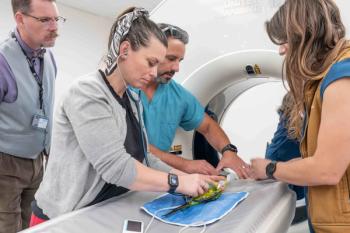
Messin' with intestines: ultrasonography of the GI tract (Proceedings)
Sonographic evaluation of the gastrointestinal tract is a routine part of the diagnostic investigation of gastrointestinal disorders. Improved visualization of the GI tract has been achieved due to technologic advances in both ultrasound machines and with the development of higher frequency transducers.
Sonographic evaluation of the gastrointestinal tract is a routine part of the diagnostic investigation of gastrointestinal disorders. Improved visualization of the GI tract has been achieved due to technologic advances in both ultrasound machines and with the development of higher frequency transducers. The main limitation of gastrointestinal ultrasonography is the presence of gas (inside or outside the gastrointestinal tract). Contrarily, if the lumen of the bowel is filled with fluid, mucus, or food, evaluation of the walls is improved. Wall layering and thickness as well as relative motility can be evaluated in different segments of the intestines. Five ultrasonographic layers can be identified throughout the GI tract. From the lumen to the serosal surface, one can visualize the hyperechoic mucosal interface, the hypoechoic mucosa, the hyperechoic submucosa, the hypoechoic muscularis layer, and the hyperechoic subserosa and serosa. The mucosal layer is normally thicker than the muscular layer, but these can become similar in thickness during peristalsis. The duodenum is easily differentiated from the jejunum and ileum by its fixed location along the right lateral abdominal wall. The duodenal walls are slightly thicker (3-6mm) than the jejunum (2-5mm).
When interrogating a suspected abnormal GI segment, wall thickness, layering, symmetry at the lesion site, extent of the lesion, GI contents, GI motility, and affected regional tissues should be noted. The most common ultrasonographic sign of GI disease is wall thickening. However, this finding is nonspecific and has been reported in both inflammatory and neoplastic diseases. Additionally, accumulation of luminal fluid should alert one to a motility disturbance and careful evaluation for a GI lesion in this area is indicated.
Studies in the past documented differences in the ultrasonographic appearance of the GI tract with non-specific enteritis compared to intestinal neoplasia. Neoplasia usually shows loss of wall layering, more severe wall thickening (>1.5cm), more commonly had focal distribution, and draining jejunal lymph nodes are larger (>1.9cm). Enteritis results in mild to moderate diffusely distributed intestinal wall thickening, without loss of layering. Corrugation of the intestines has been seen with enteritis, but also can be associated with pancreatitis, peritonitis, thrombosis/ infarction and protein losing enteropathy. Intestinal wall thickness, though increased with enteritis, is insensitive and a nonspecific indicator of the presence and differentiation of inflammatory bowel diseases. Recent studies have identified other ultrasonographic changes in the bowel which help to differentiate between specific causes of enteritis with relatively high sensitivity and specificity. Mucosal echogenicity may be a better parameter for detecting inflammatory disease of the intestines in dogs with chronic enteropathies. Changes to the normal hypoechoic echogenicity of the mucosal layer can be used to predict likely etiologies of intestinal diseases. With food responsive enteropathies (due to food allergies), the normally hypoechoic mucosal layer was unaltered. A diagnosis of protien losing enteropathy with associated lymphangiectasia was highly correlated with increased mucosal echogenicity. With this diagnosis, the increased mucosal echogenicity appeared as linear hyperechoic mucosal striations, oriented perpendicular to the bowel lumen. Hyperechoic mucosal speckles are sensitive for the presence of inflammatory disease, yet they are non-specific for differentiating disease category. Interestingly, the increased mucosal echogenicity, regardless of underlying disease, did not resolve with treatment.
Parvovirus enteritis has also shown to have very specific ultrasonographic changes when compared to the normal gastrointestinal tract of puppies. Parvovirus causes significant mucosal thinning of the duodenum and jejunum related to villus sloughing and mucosal erosion/ ulceration. Mucosal thinning is present with concurrent overall normal wall thickness. Contrarily, other causes of enteritis result in increased overall wall thickness. Additional findings with parvovirus enteritis include diffuse fluid filling of the small and large intestines without normal peristalsis, duodenal hyperechoic mucosal speckling, duodenal and jejunal corrugation, and generalized indistinct wall layering.
The jejunal lymph nodes drain the jejunum, ileum, and pancreas and are also called mesenteric lymph nodes. They are the largest lymph nodes in the dog. In normal adult canines, they have been reported to average between 5-6mm in thickness. These lymph nodes normally are fusiform in shape with distal irregular lobulation, mostly homogenous in echotexture, isoechoic to slightly hypoechoic to surrounding tissue, and have hilar blood flow. Intra-abdominal lymph node enlargement is commonly seen in both inflammatory and neoplastic conditions. Dogs with intestinal disease have a jejunal lymph node thickness greater than 6mm. Mild to moderate lymph node enlargement can be seen with inflammatory or infectious bowel disease, but the size of mesenteric lymph nodes did not correlate well to the type of inflammatory disease present. Differentiation between benign and malignant lymphadenomegaly is not possible with gray scale sonographic features alone and Doppler evaluation additionally can be beneficial. Ultrasonographic changes consistent with benign processes include a hyperechoic lymph node hilus and hilar blood flow seen with Doppler. Gray scale changes associated with neoplasia include lymph nodes that are round in shape and hypoechoic in echogenicity compared to surrounding tissue. Doppler blood flow in malignancy tends to have a more peripheral blood flow pattern. Heterogenicity of the jejunal lymph node is also highly associated with malignancy in canines and is due to liquefaction and coagulation necrosis, calcification, as well as neoplastic infiltrates.
Juvenile abdominal lymph nodes are quite different than adult lymph nodes in size, vascularity, overall echogenicity and lack of homogeneity. In normal puppies, jejunal lymph node thickness averages 7.1mm, which is significantly larger than described for adults, especially in light of the smaller overall size of puppies. This increased size is likely due to higher immunologic activity. Doppler evaluation of juvenile lymph nodes show overall increased vascularity compared to adult dogs. In dogs less than 2 years of age, the mesenteric lymph nodes are more hypoechoic in echogenicity than in adults. After 2 year of age, the lymph nodes begin to appear normally isoechoic to the surrounding mesentery, as expected with normal adults. Young dogs also show non-uniform echogenicity of the jejunal lymph nodes. A wide hypoechoic rim of uneven diameter, susupected due to an immunologically active lymph node cortex, is normally present in puppies less than 2 years of age. In dogs between 2-6 years of age, the hypoechoic cortical rim in the mesenteric lymph nodes can be present but is thin and uniform. These findings should be interpreted with the knowledge that normal juvenile mesenteric lymph nodes differ from adult canine abdominal lymph nodes.
Another important use of gastrointestinal imaging is differentiating between a normal healing postoperative enterotomy/ enterectomy site and peritonitis due to surgical site dehiscence. Specific ultrasonographic differences have been found between these two situations. Intestinal surgical sites are easily identified by visualization of irregular hypoechoic serosal margins, locally thickened bowel wall with altered to absent wall layering, surrounding hyperechoic fat and the presence of hyperechoic, double walled foci seen at regular intervals (which represent suture material). Progressive localized fluid accumulation, along with altered bowel wall layering and intestinal thickening are described ultrasonographic features of intestinal perforation. Presence of fluid adjacent to a surgical site however is not pathognomic for dehiscence. Between 3 and 10 days post-operatively, normal post operative peritoneal fluid is absorbed and hyperechoic reactive mesentery adjacent to the surgical site resolves. After 10 days, 80% of patients in one study had no evidence of peritoneal effusion. Increased wall thickness (7-8mm) and alterations in normal wall layering were persistent in most dogs at 10 days post operatively and should not be interpreted as pathology. Resolution of post operative pneumoperitoneum ultrasonographically appears to be similar to reported radiographic resolution of pneumoperitoneum. On day 1, 95% of patients showed generalized or focal gas accumulation in the peritoneal space, while by day 10, pneumoperitoneum was noted in only 15% of patients.
Careful evaluation of the gastrointestinal tract for changes in wall layering, wall thickness and mucosal echogenicity, combined with gray scale and Doppler interrogation of the draining jejunal lymph nodes should be considered to discriminate neoplasia from inflammatory diseases of various etiologies. Normal postoperative intestinal surgery sites should be assessed for resolving localized fluid, regional hyperechoic mesentery, and pneumoperitoneum over a 10 day period of time to identify patients with surgical dehiscence.
Newsletter
From exam room tips to practice management insights, get trusted veterinary news delivered straight to your inbox—subscribe to dvm360.






